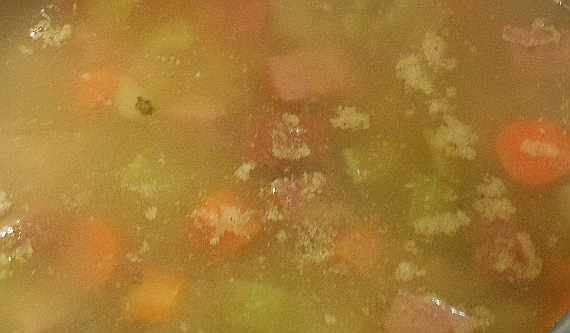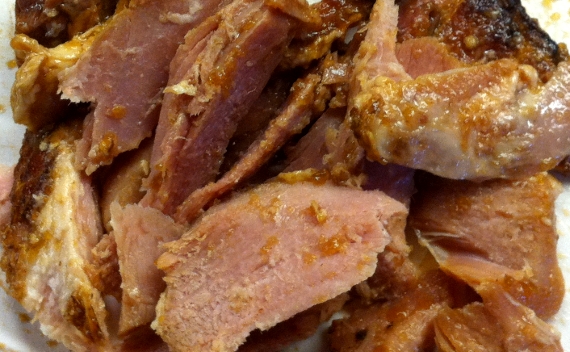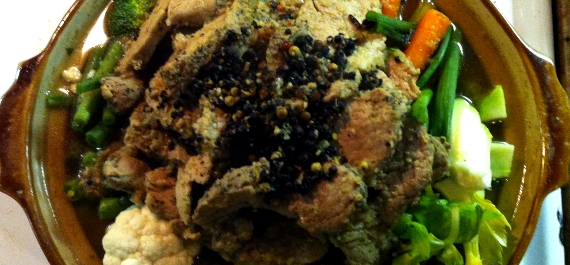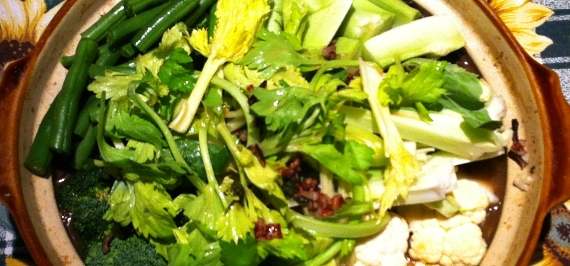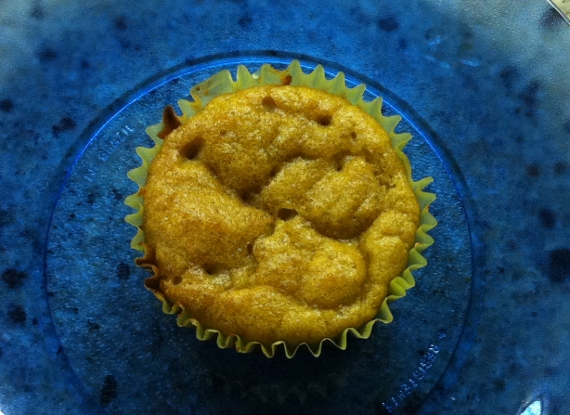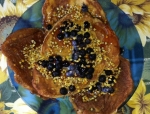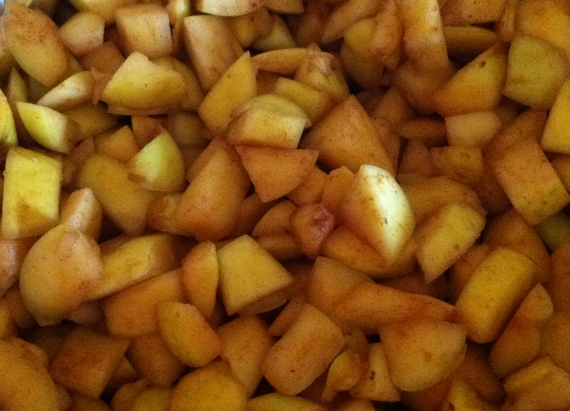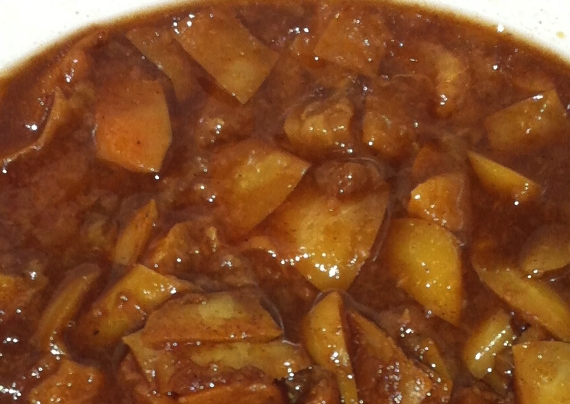I really enjoy red velvet cake and buy a gluten-free vegan piece whenever I find it at a store, bakery or restaurant, so I decided to treat myself for my birthday when my folks came to celebrate with me. I made my adaption from a recipe I found at the Gluten-Free Food Examiner, which looked really intriguing, but I wanted to make a healthier version. I was a bit leery of the recipe’s large amount of beets and was unsure how potent the the red color or earthy root flavor would work in this cake compared to the small amount of chocolate. The cake batter of this first attempt ended up tasting too much like beets but had a great raspberry shade. The chocolate lacked flavor intensity, but the batter was at least sweet. It needed more chocolate, so I quadrupled the amount of cacao when doubling was not enough. Unfortunately, adding this much chocolate made the batter much thicker and a very dark shade of brown. As bright red coloring faded a significant amount as while baking, it came out not looking red at all, so left out the red dye in the recipe listed below. Although the the concoction was tasty to me, they were not to everyone’s liking, as some changes to the recipe resulted in rather an intense dark chocolate flavor. (I prefer my chocolate very dark and bitter, sometimes eating dried cacao beans or 89 percent to 100 percent dark chocolate bars.)

The vegan cream cheese frosting that I made is AMAZING! It tastes and feels like REAL cream cheese frosting! It is sweet, tart, light and fluffy. It’s not healthy enough to eat by the spoonful but provides a perfect accompaniment to red velvet, various spice cakes or really in any other recipe that calls for cream cheese frosting. The original recipe called for too much sugar, and the frosting made from it appeared too sweet for my brownies. I listed the reduced powdered sugar measurement (see the recipe below), which prevented the frosting from overpowering the brownies. Feel free to experiment with other dry sweeteners, but I’m not sure how the recipe will turn our if you do. I do not recommend using liquid sweeteners, as the powdered sugar seemed to absorb some of the oils in the cream cheese and prevented the frosting from becoming too greasy.
I used Daiya’s new non-dairy plain cream cheese, which already has an incredible taste and texture by itself; it even has that classic cheesy tartness that is usually so difficult to simulate without fermentation. I first stumbled upon their cream cheese when I was perusing their non-dairy cheese selection on the Daiya website. I thought to myself, “With all of the recent progress in the foodie world with gluten-free, dairy-free and vegan foods, someone has to have a created a not only decent but good dairy-free cream cheese by now. I wonder if Daiya has one yet….” Lo’ and behold (and luckily for me), they do! I really like their other non-dairy cheeses, so I thought I might as well try it. Why not?
Roast Beet Purée
Adapted from the roasting instructions for Jessica’s red velvet cake at Desserts with Benefits.
Ingredients
2 Large Beets, scrubbed, trimmed
1 1/2 tsp Fresh Lemon Juice
Directions
Preheat the oven to 400 degrees F. Wrap the beats in aluminum foil. Place on a foil-lined lipped baking sheet due to a tendency for the beet juice to bubble over through the wrapping. Roast for an hour or until a fork easily pierces through the flesh. Cool slightly on a wire rack. Unwrap the beets. Be careful not to burn your hands. Quarter them before pureeing in a food processor or high-speed blender with the lemon juice.

Gluten-Free Chocolate Chip Beet Brownies
Adapted recipe from Jen Cafferty’s recipe on the Gluten-Free Food Examiner.
Yields 15 to 20 Servings
Ingredients
3 T Chia or Flax Seeds, course ground
8 T Warm Filtered Water
2 C Cacao Powder
1 1/2 C Unsweetened Apple Sauce
2 tsp Vanilla Extract
1 – 2 C Evaporated Cane Juice or Turbinado Sugar
1 3/4 C Gluten-Free All-Purpose Flour
1 1/4 tsp Xanthan Gum
1 1/2 tsp Baking Soda
1/2 tsp Sea Salt
1 C Roast Beet Puree (see above)
20 oz Vegan Chocolate Chunks or Chips
Vegan Cream Cheese Frosting (see below)
Red Sanding Sugar, optional
Directions
In a small bowl, beat chia or flax seeds and water with a fork until smooth to create “egg” substitute. Set aside for 15 to 20 minutes, stirring occasionally to prevent clumping.
Preheat oven to 350 degrees F. Grease and flour-dust a glass 9″ x 13″ baking dish. Set aside.
In a large bowl, mix cacao, apple sauce and vanilla. Set aside.
Into a medium bowl, sift flour, xanthan gum, 1 cup sugar, soda and salt. With an electric mixer, gradually add in cacao-apple mixture. Blend in “eggs” and beets. Stir until fully incorporated. Adjust batter to desired level of sweetness with remaining sugar, mixing in a quarter cup at a time. Fold in chocolate pieces.
Bake for at least 30 minutes (mine took 70) or until toothpick inserted in center comes out clean. Cool thoroughly on wire rack. Frost and decorate as desired.* Serve and enjoy!
*If you do not want to frost the brownies, they would also taste great accompanied by vanilla ice cream or whipped cream.

Vegan Cream Cheese Frosting
I adapted this cream cheese frosting made by Rachel Young of Gladly Gluten Free.
I doubled this recipe from the original, since I planned to make cakes for two different occasions.
Yields 40 to 48 Servings.
Ingredients
16 oz Daiya Plain Cream Cheese, softened
2 C Earth Balance Spread, softened
2 tsp Vanilla Extract
4 C Powdered Sugar, to taste
Directions
Combine the cream cheese and spread in a large bowl until fluffy.Thoroughly incorporate the vanilla. Sift the sugar to get rid of lumps, gradually adding four cups of sugar to the cream, using an electric mixer. Adjust the frosting to your level of desired sweetness by slowly adding up to another cup of sugar. Store leftover frosting in a large airtight container, like a glass canning jar, for up to a week; just make sure you let it soften it a bit before attempting to spread it on a cake.
